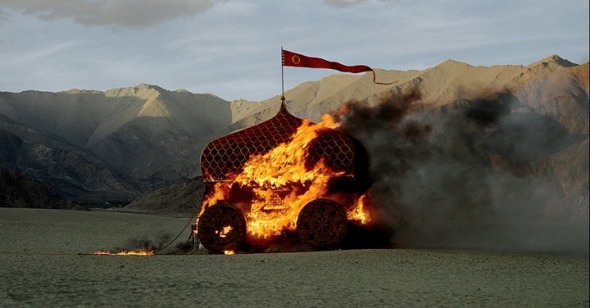Imagine That
by Michael Joshua Rowin
The Fall
Dir. Tarsem Singh, U.S., Roadside Attractions
Playwright John Guare must have had Indian director Tarsem Singh (or as heâs often simply known, Tarsem) in mind when he wrote about the increasing exteriorization of the term âimaginativeâ: âWhy has âimaginationâ become a synonym for style?â Singh makes films that inspire a bevy of similarly misused adjectives: âsumptuous,â âsurreal,â âeye-popping,â âhallucinatory.â He specializes in audacious compositions, shoots in exotic locales, fits his actors in unique costumes that appear simultaneously futuristic and old-fashioned, and in only two features, including the new and fifteen years in the making The Fall, has shown a predilection for stories about, yes, âthe power of the imagination.â Unfortunately, lacking the ability to fashion cohesive tales driven by engaging characters, Singh overcompensates with his trademark visual palette and loses a hold on both in the process, a fatal flaw that can be traced back to his only other non-advertising work, the poetically vacuous video for R.E.M.âs âLosing My Religionâ and the Silence of the Lambs-as-DalĂ-toss-off The Cell. His is a classic case of a natural-born cinematographer playing at being a filmmaker.
Based on the 1981 Bulgarian film Yo Ho Ho and cowritten by Singh with Dan Gilroy and Nico Soultanakis, The Fall takes place in Los Angeles 1915 (âOnce upon a time,â of course) and stars Lee Pace as Roy Walker, a movie stunt man who winds up in the hospital after falling off a horse on the set. Laid up and unable to bear the sight of his nurse girlfriend (Justine Waddell) leaving him for a handsome star, Roy decides to kill himself by convincing five year-old Romanian immigrant Alexandria (Catinca Untaru), also in the hospital recovering from a fall, to steal him a bottle of morphine so he can take a fatal dose. He befriends her by telling a fantastic fairy tale in which he plays the Black Bandit, Alexandria his daughter, the nurse a princess, the star the evil Governor Odious, and a group of ragtag supporting foreigners (The Indian, The Italian) from the hospital the Black Banditâs loyal followers, including a peacock-coated and monkey-aided Charles Darwin (Leo Bill), each holding their own personal grievances against the villain.
Liberally taking its structure and epic storybook whimsy from The Wizard of Oz and The Princess Bride, The Fall squeezes every bit of âimaginationâ out of lavish costume designs and the two dozen countries used as settings: exotic temples, swimming elephants, a city of blue stone buildings, whirling dervishes, a huge sheet dripping blood in the middle of a desert. Add religious overtones (âAre you trying to save my soul?â Roy asks Alexandria), rich symbolism (teeth, butterflies, dolls), a self-referential paean to the magic of purely visual cinema (the film concludes with a montage of silent-era slapstick classics), and youâve got a whole lotta movie.
Then why does The Fall end up feeling so empty? Singh should be given credit where itâs due: heâs followed through on his vision with a monumental undertaking, and heâs also improved upon the empty-headed horror of The Cell by crafting a film both fun and serious in nature. But this labor of love doesnât come together because its storyâso essential in a movie about storytelling, after allâjust isnât there. The characters on the reality side of the rainbow are completely one-dimensional, which leads Singh to make terrible decisions like seemingly allowing Untaru room for improvisation (her wriggling and adorable line readings grate). On the fantasy side, his exaggerated art direction and color schemesâred blood is RED; desolate locations are DESOLATEâgrow punishing in their immodest scale and melodramatic excess, forcing the often sloppily told tale to take a backseat to the directorâs visual grandiosity. Iâm not ungenerous enough to say certain moviegoers would be wrong to be moved by The Fall, and maybe my disapproval is a simple matter of taste for the unassuming over the ostentatious; but I also canât help but compare it to Hou Hsiao-hsienâs latest, Flight of the Red Balloon, a film that so gently and delicately creates a world of enchantment out of the raw elements of everyday life that it proves wonder can be achieved without bludgeoning the viewer into submission.
